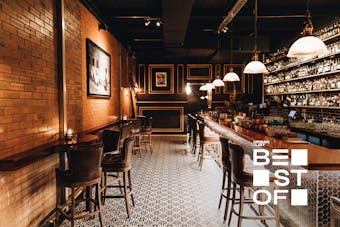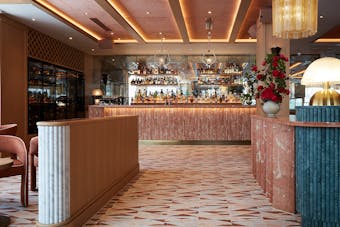Trending
35 Of The Best Restaurants In Brisbane Right Now
These Brisbane restaurants are the must-dos, the have-to-tries, the places you would tell visiting friends to dine at, and the bucket-list special treats to book when you want to splash out.
30 Of The Best Things To Do In Brisbane
Here are 50 of the absolute best things to do in Brisbane, whether you’re a local or not.
50 Of The Best Cafes In Brisbane That You Should Have Eaten At By Now
Whether you dig on granola or the greasy fry-up, these are 50 of the best Brisbane cafes (in no particular order) you can depend on—consider it your 2025 to-do list.
The Latest
Tommy Casha On The Power Of Good Chats And Finding Time For Mates
We all need connection, but sometimes it's easier said than done. So we asked "full-time chatter" Tommy Casha for his advice on getting through.
Luxury Escapes Just Announced Limited-Time Deals For These Top Destinations
Whether you're looking for a beachside vacation in Southeast Asia or you want to see what delights Australia has to offer, here's how you can experience a luxury vacation without breaking the bank..
What’s On In Brisbane This Week, This Month And Beyond
Here's all the best events and happenings coming up in Brisbane soon.
Layla
Bold and moody, Shane Delia's first Queensland restaurant packs a spice-filled punch.
Commercial Hotel Boonah
The century-old Commercial Hotel Boonah has been lovingly restored, reopening with an on-site craft brewery—Boonah Brewing Co.
Dakabin Hotel
From the arcade to the sunken fireplace, the highly anticipated Dakabin Hotel is opening this week.
Lord Stanley Hotel
East Brisbane’s iconic pub has reopened after a $15 million transformation.
From Lookouts To Experiences, Here’s Your Guide To Whale Watching Near Brisbane
Every year, the humpback whales come to town with plenty of ways to experience the magic first-hand.
Rise Of The Unorthodox Cooks: Meet The Young Guns Flipping The Script On Home Cooking
How untrained and unorthodox home cooks are ushering in a new wave of food enthusiasts.
Slouchy To Barrel Leg: Your Guide To Finding Jeans That Fit Every Vibe
From casual Friday to Sunday lunch with the gals, good denim works for every occasion.
Coming Soon: Queen Amann Bakery
King Street’s new bakery specialises in flaky and buttery kouign-amann.
Coming Soon: Power Moves Newstead
Redefining boutique fitness, Power Moves is more than just a Pilates studio.
The Summit Restaurant
This multi-million-dollar revitalisation pairs iconic views with Queensland flavours.
This Masterfully Reimagined Swan Lake Is Like Nothing You’ve Ever Seen
Ballet Preljocaj is bringing a reimagined Swan Lake to Brisbane, transforming Tchaikovsky's musical masterpiece into a modern tragedy.
Here’s How To Spend 72 Hours In Auckland, According To A Local
Just a short flight from Australia's Eastern Seaboard, Auckland is close enough for a quick escape, but far enough to reset your rhythm—this is how to make the most of it in 72 hours.
A Complete Guide To Brisbane’s Best Markets
From weekend produce markets to late night artisan pop-ups, here are all the best Brisbane markets that are worth visiting.
Oxford 152
Oxford Street’s one-and-only pub has unveiled its $1.72 million transformation.
Wild Legs Wine Room
Newstead’s new wine room is putting indigenous and unheard grape varietals in the spotlight.
Coastal Walks And Titanique: Sandy McIntyre’s Ideal Sydney Winter Weekend
Sandy McIntyre is the actor, writer, producer and model making waves across Australia’s creative scene. We picked their brains on the best of what to do in Sydney this winter season.
Our Travel Editor’s Guide To Australia’s 50+ Best Places To Stay In 2025
Ready to plan your next getaway? Discover the top 50 places to stay in Australia for 2025, from secluded forest cabins to luxurious beachside resorts.
Slow Staycays Are In For 2025—And This Luxe Hotel Is Nailing The Brief
After a few hours scoping out the facilities, you’ll discover there’s no real reason to leave The Westin Brisbane—everything you need for a good time is at your fingertips.
Pippa’s Pantry
Camp Hill’s new all vegan bakery is pretty, pink, and full of pastries.
Puck
Puck is Newstead’s new dog-friendly bar and cafe for seasonal tapas and wine by the riverwalk.
Hai Hai Ramen West End
Cult-fave Hai Hai Ramen has opened a second location in West End.
Marble Korean Steakhouse
Korean BBQ meets a modern steakhouse in Portside Wharf’s new elegant spot, Marble Korean Steakhouse.
Where To Go Ice Skating In And Around Brisbane
In a region where the sunscreen industry is eternally booming, why not shake things up with a day on the ice?
37 Of The Best Restaurants In Brisbane’s CBD
It’s easy to overlook Brisbane's incredible CBD restaurants when you’re planning a dinner out.
19 Of Brisbane’s Best Furniture Stores And Antique Shops To Deck Out Your Crib
Home is where the heart is, and our hearts are beating for an updated space decked out in dreamy homewares.
Krabby’s Crab Boil
Pouring up Louisiana-style seafood boils, Krabby’s Crab Boil has officially arrived in Brisbane.
The Beach Hotel Stradbroke Island
Big things are happening on Stradbroke Island—the legendary Beach Hotel is getting a serious glow-up.
TAMA Supper Club
TAMA, the iconic fine-dining institution in the Fortitude Valley, has rebranded.
Coming Soon: TABOO
Massaman curry and cocktails on a rooftop? We’re intrigued—and that’s what’s coming to the Valley soon with the arrival of TABOO.
Where To Find 20 Of The Best Breakfasts In Brisbane In 2025
Instead of settling for burnt toast or microwaved porridge, launch yourself into post-dawn endeavours that won't leave you disappointed.
29 Of The Best Bars In Brisbane
From raging rooftops to intimate wine bars, gin joints and whisky dens, here are some of Brisbane’s best bars that you really should have had a drink in by now.
23 Of The Best Netflix Documentaries To Watch In 2025
We've rounded up the best Netflix documentaries you need to watch right now. From the intriguing to the shocking, it’s all here.
D.Vino Bistro & Vinoteca
Tucked away in Woolloongabba is where you’ll find D.Vino Bistro & Vinoteca, an uber romantic dining spot from the owner of Ashgrove’s Arcade Wine.
Stilts
It was only a matter of time before we got our first restaurant on a bridge, and with the opening of Stilts, the new green bridge from Kangaroo Point to the city features just that.
Donana Mini Hotpot
At Kelvin Grove’s new hotpot spot, your soup pot is brought to you by robot train and you grab fresh ingredients from a conveyor belt.
Mulga Bill’s
City commuters, say hello to your new morning go-to, with Mulga Bill’s opening on the CBD side of the Kangaroo Point Bridge.
The Best Things To Do In Brisbane This Weekend
Here are the best things to do in Brisbane this weekend.
Evra’s Breathtaking New Farm-To-Table Restaurant Is Opening This Month
Seasonally driven with a focus on the best home-grown produce, this stunning spot captures the beauty of Australian ingredients.
Paniyiri Is Returning This Week So You Can Eat Your Weight In Honey Puffs
Paniyiri is back with plenty of Greek goodness to go around.
The Fifty Six
Joining the Naldham House line up is The Fifty Six, a vibrant new Cantonese restaurant led by chef Gerald Ong.
Stickybeak Wine Bar
A new self-pour wine bar, Stickybeak, has landed in Woolloongabba, and it’s the perfect addition to Brisbane’s vibrant bar scene.
Acciuga
This family-owned modern Italian restaurant hidden away in sleepy Sandgate is set to be a destination eatery.
Here Are The Best Click Frenzy Mayhem Deals For Fashion, Beauty, Home And More
We always jump at the opportunity of a great deal, which is why we're excited about the huge Click Frenzy Mayhem sale
We’ve Mapped Out The Ultimate NZ Road Trip So You Don’t Have To
Planning your winter escape? Swap your snowboard for the steering wheel with an unforgettable road trip around New Zealand’s North Island.
Slurp Up A Bowl At 16 Of Brisbane’s Best Ramen Spots
Want to know where to get Brisbane's best ramen noodles? Listen up.
Wang Chung
Lobster sandos and wasabi margaritas by the water await at Manly’s newest arrival, a breezy, oceanside pan-Asian spot.
Goros
Start warming up your vocal chords, because a vibrant, multi-level Japanese izakaya and karaoke bar has opened in the Valley
The Newmarket Hotel
The Newmarket Hotel (a self-proclaimed “local, for the locals”) has revealed a new look after undergoing a remarkable transformation.
35 Of The Best Restaurants In Brisbane Right Now
These Brisbane restaurants are the must-dos, the have-to-tries, the places you would tell visiting friends to dine at, and the bucket-list special treats to book when you want to splash out.
Beachside Brunches And MJ The Musical: Millie Elliott’s Ultimate Sydney Saturday Off The Pitch
If there’s one person who knows how to make the most of a weekend in Sydney, it’s the powerhouse NRLW player, sharp-witted commentator, and podcast co-host Millie Elliott.
16 Of Brisbane’s Best Korean Restaurants
Here’s where to find the best Korean restaurants in Brisbane, whether you're looking for KFC, topokki or bibimbap.
C’sis Espresso
New Thai-inspired cafe C’sis Espresso has just landed in Bowen Hills, bringing both decadent pancake stacks and hearty lunchtime curries to a cosy cottage on Brookes Street.
Pilates Place
Boutique wellness studio Pilates Place has officially opened the doors to its second location in the Yerongpilly Green Village complex.
These Luxe Retreats Are Some of Australia’s Best—And They Just Dropped an Epic Sale
From rainforests to art deco terrace homes, treat yourself to a retreat among picturesque surroundings this Easter.
Drift Into The Best Go-Karting Tracks In And Around Brisbane
Leave the banana peels at home becauswe these are the best go-karting tracks around town.
26 Of The Best Stays Near Brisbane For Big Groups
We’ve rounded up a few of our favourite Airbnbs perfect for big groups near Brisbane, so all that’s left to do is work out the maths (they’re cheap if you divide the price by eight).
The 203
The Valley is undergoing a serious makeover at the moment, with stellar food and drink venues opening on almost every corner, and many more to come. One such arrival is The 203 at 6 Marshall Street—a space that has seen a revolving door of nightclubs but is now an elevated spot for dry-aged steaks and Italian pastas.
Hideki
Step through the huge black door that marks Hideki's entrance and you’ll find a stunning, atmospheric Japanese restaurant inside.
Little Red Bakery
We've gone and fallen head over heels for cute-as-a-button Brisbane cafe, Little Red Bakery.




























.png?auto=format,compress&w=340&fit=crop&ar=3:2)










.png?auto=format,compress&w=340&fit=crop&ar=3:2)
.png?auto=format,compress&w=340&fit=crop&ar=3:2)






















.png?auto=format,compress&w=340&fit=crop&ar=3:2)











